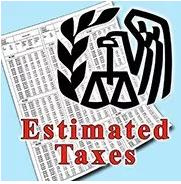 Understanding Your Estimated Tax Payments:
Understanding Your Estimated Tax Payments:
As the second estimated tax deadline just passed, it may be helpful to understand your estimated tax payment responsibility. The United States income tax system is a pay-as-you-go tax system, which means that you must pay income tax as you earn or receive your income during the year. You either can do this through withholding or by making estimated tax payments. Even if you have an employer withholds tax on your paycheck, you cannot forget about other sources of income such as rental, self-employment, investment, or capital gains.
Estimated Payment Due Dates:
|
Quarter |
Dates Included |
Payment Due Date |
|
1 |
January 1, 2018– March 31, 2018 |
April 17, 2018 |
|
2 |
April 1, 2018 – May 31, 2018 |
June 15, 2018 |
|
3 |
June 1, 2018 – August 31, 2018 |
September 17, 2018 |
|
4 |
September 1, 2018 – December 31, 2018 |
January 15, 2019 |
General IRS Rule (Safe Harbor):
The IRS has determined two options for determining estimated payments. Generally, if calculated correct no underpayment penalties should apply. You can choose between the lower of the options. Once determining the full amount, evenly breakdown the payments throughout the year.
Option #1: Pay 90% of the tax to be shown on your 2018 (next tax year) tax return.
This amount can be hard to determine since the tax year is still on going and with tax law changes. Some reasons you may choose this option are: you are retiring, tax reform changes are in your favor, you sold investments in the prior year, quit your job, or other circumstances where your income would be lower.
Option #2: Pay 100% of the tax to be shown on your 2017 (current year) tax return. If your AGI (adjusted gross income) is more than $150,000 ($75,000 for married filing separately), replace 100% with 110%.
How to Pay:
- Using IRS Form 1040-ES, cut out the voucher and mail with check
- Direct pay with the IRS online https://www.irs.gov/payments/direct-pay (individuals) or EFTS for https://www.eftps.gov/eftps/ (businesses)
Suggestions:
Business Owners:
- It may be helpful to set up a separate bank account or “piggy bank” each month for tax payments
- Set up recurring payments with EFTPS, the IRS’s electronic federal tax payment system
- If applicable, increase the withholdings with your spouse’s employer
- Don’t forget to let our office know if you are planning to make a large transaction or complete a large job so we can help calculate that quarter’s payment
Individuals:
- Increase your employer withholdings. The IRS has provided a calculator that helps you identify your tax withholding to make sure you have the right amount of tax withheld from your paycheck at work. https://www.irs.gov/individuals/irs-withholding-calculator
- Provide BKHM with the most accurate information when it becomes available to you. This information is needed for us to calculate a more accurate estimate. Complete questions in your organizer regarding future changes in income, marital status, or other financial changes.
From a business and individual standpoint, some states require estimated tax payments and have their own calculations as well. Please feel free to contact our office is you have questions or need assistance with your estimated tax payments
Penalties:
A penalty may apply even if you have an overpayment. Form 2210 is used to calculate your tax penalty. It calculates your required annual payment and compares that to your estimated payments and withholdings for the days unpaid.
If you have any questions regarding estimated payments please contact us at bkhm@bkhmcpa.com.




Post Comment